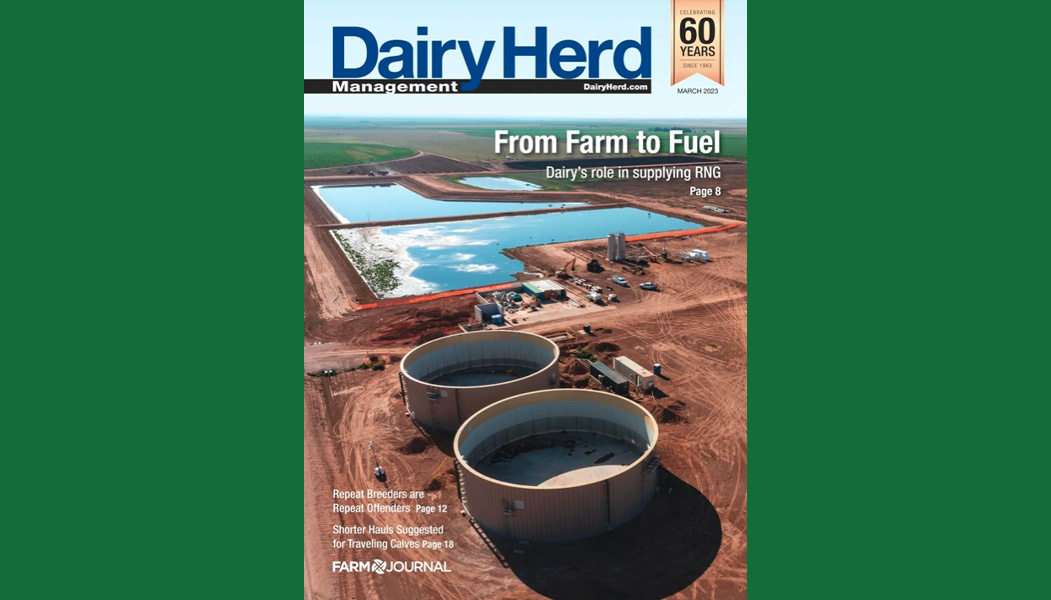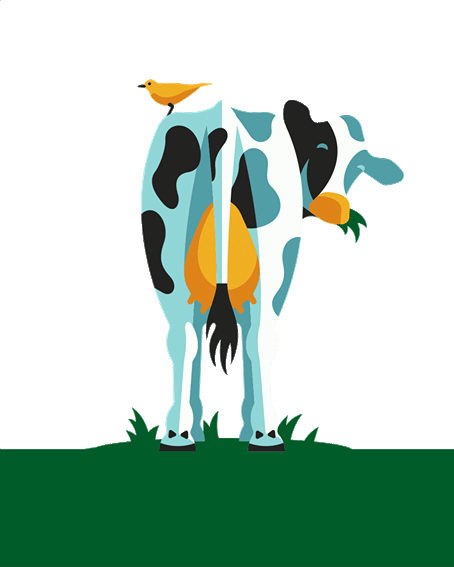From Farm to Fuel: Dairy’s Role in Supplying Renewable Natural Gas

By Taylor Leach – March 6, 2023 – Dairy Herd Management
What goes in, must come out. That’s the saying every dairy farmer knows all too well as they deal with manure on a daily basis. While this byproduct of making milk has commonly been seen as a nuisance, some dairy farmers are using it as a tool to generate additional income for their farms, and the results make sustainable sense both on a financial and environmental front.
Nestled between Amarillo, Texas and Clovis, N.M., you’ll find Del Rio Dairy, an 8,100-cow operation outside Friona, Texas. While the town might be small, the dairy set big goals in 2021 to convert their manure into renewable natural gas (RNG). Those goals are just about to become a reality.
“February 14 is the first day we’re actually going to be putting gas in the line,” says Rocky Gingg, who farms alongside his wife, Liz, his daughter and son-in-law, Crystal and Nathan Moroney. “It’s exciting to see this all come to life.”
Just two years prior, Gingg was approached by Peter Drasher, a developer for Black Bear Environmental Assets who was familiar with working on methane digester projects. Drasher had just installed a digester for friends of the Ginggs, the VanHofwegens, on an Arizona dairy, and they suggested he reach out to Del Rio Dairy as the next potential candidate.
Gingg was intrigued by the opportunity and agreed to give the project a shot.
“Peter introduced us to all of this,” Gingg says. “He knew we were the right size and in the right location. He’s the one who helped us partner with Clean Energy.”
Clean Energy Fuels, a natural gas distribution company in Newport Beach, Calif., is no stranger to working with dairies. The company specializes in transforming manure methane emissions into RNG and is the largest provider of RNG to the transportation industry.
“We have fueling stations in 40 different states, and we’re buying gas from just about every major dairy region in the country,” says Clay Corbus, senior vice president of strategic development at Clean Energy. “We’re forging partnerships with dairies because we believe RNG is a sustainable solution for the transportation industry, and who’s more sustainable or better to work with than dairy farmers?”

How It’s Made
While dairy cows are known for their ability to make milk, they’re also scrutinized for their ability to produce methane, a potent greenhouse gas (GHG) emission. According to EPA, agriculture accounts for nearly 10% of U.S. GHG emissions. However, the dairy industry plays a big role in being part of a global climate solution.
“Renewable natural gas is chemically the same as the natural gas you might get in your stove, but what makes it renewable is that it is sourced from landfills or dairy farms,” says Will Flanagan, vice president of strategic development at Clean Energy. “What we’re doing is gathering manure and putting it in a digester, which captures the raw methane, or biogas, that would otherwise be going into the atmosphere. Then we pipe that raw biogas to an on-site gas processing plant where we clean it up by taking out the unwanted constituents.”
Once the methane has been converted into RNG, it is injected into a local natural gas pipeline and distributed to one of Clean Energy’s 540 fueling stations.
A Nationwide Project
Clean Energy is purchasing RNG from approximately 100 dairies across the U.S. and is actively building digesters at seven dairies this year. One of those is South Fork Dairy, owned by Evan Barton in Newark, Ohio.
“We’re set to break ground on the project this spring,” Barton says. “If everything goes right, it should take six months to a year to build.”
Barton, who milks 2,500 cows just 40 miles east of Columbus, began conversations with Clean Energy in 2021.
“When we first started talking, the biggest hurdle was making the digester profitable while still being able to bed with sand,” Barton says. “Digesters are more profitable if you bed the cows with manure solids, but I didn’t want the profit of the digester to be offset by a loss in health and performance of the cows. In the end, we found a way to keep the cows on sand bedding and still have a viable digester project.”
Finding an engineer and determining costs was another big step in the process. Fortunately, grants were available to help bring down the cost to build the digester.
“Nothing happens overnight,” Barton adds. “I will be a partner in the project, so there are a tremendous amount of contracts along with partnerships and operating agreements. All of those things take time, but in the end, it should all be worth it.”

The Benefits
In today’s world, companies and consumers are hyperfocused on sustainability. However, dairy farmers have been focused on sustainable practices since the beginning. Now, as the need to become more sustainable grows, farmers can capitalize on their efforts.
“We take great pride in the sustainable way in which we operate,” Gingg says. “By adding a RNG digester to our operation, we will be able to say to future generations that we are helping to address serious climate issues that impact the world they live in.”
Helping to power the transportation industry by using the methane captured from farms not only helps a farm improve its sustainability efforts, but also has the ability to generate additional income.
“Once the finances start coming in, and as it gets harder and harder to be profitable in the dairy industry, we could make more money selling gas than we make selling milk,” Barton says. “There’s going to be a return on investment for us, plus we’re going to be more sustainable because of it.”
Flanagan notes there are environmental benefits that also stem from producing RNG. These include:
- Reduced runoff
- Less odor
- Fewer GHG emissions
Besides the environmental benefits, Barton is excited to see how this sustainable journey helps propel his farm forward, especially in the eyes of the consumer.
“We have a lot of neighbors; I believe the digester project and processing of the manure will reduce the odor of the effluent that gets spread on the field,” he says.
Barton believes this project will also help him with public relations.
“I don’t want my cows to be demonized in the media and political arenas for the methane they produce,” he adds. “I think this
project helps eliminate that concern and makes us part of the environmental solution, rather than part of the problem.”
A Promising Future
Grit, determination and an open mind are required to be successful and persevere in the dairy industry. Both Del Rio Dairy and South Fork Dairy are prime examples of operations that are making investments today for a better tomorrow.
“A big part of why we’re doing this is because it provides another stream of revenue to help us be more profitable and sustainable from a business standpoint, especially as margins continue to thin,” Barton says. “If we can’t be profitable, then we can’t farm. And we want to be able to keep doing this for years to come.”
Gingg agrees, adding the benefits, in his eyes, go beyond working toward a better environment and a better bottom line.
“It helps solidify the opportunity for the next generation to be able to come back to the farm,” Gingg says. “This is something my daughter and son-in-law want to be a part of, and this project gives us the ability to do what we love for generations to come.”
Clean Energy Statistics
Like the dairy industry, Clean Energy is dedicated to being a part of the global climate solution. That’s why it’s committing to becoming a zero-carbon company by 2025. So far, its sustainable statistics include:
- 25,000 vehicles are fueled by Clean Energy daily with renewable natural gas, across all transportation sectors from heavy-duty fleets, to refuse trucks, to transit buses.
- 70% of GHG emissions are reduced with RNG when compared to diesel.
- 90% of tailpipe emissions are reduced with RNG versus diesel.
- Major fleet partners include UPS, Republic Waste Management and Amazon.



